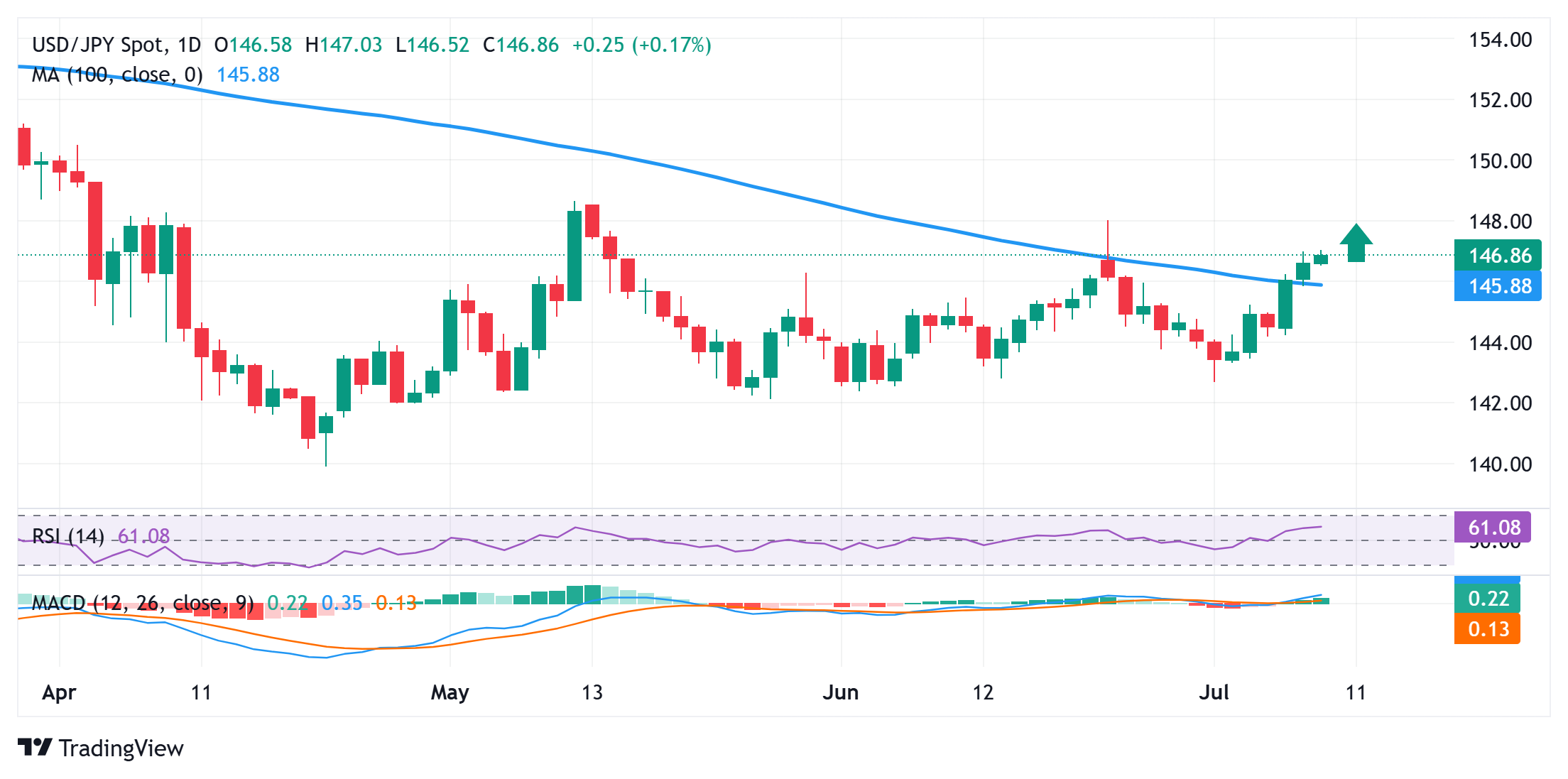Created
: 2025.07.09














![]() 2025.07.09 11:23
2025.07.09 11:23
The Japanese Yen (JPY) prolongs its weekly downtrend for the third successive day on Wednesday, pushing the USD/JPY pair to a fresh two-week high, around the 147.00 mark during the Asian session. Concerns about the economic fallout from US President Donald Trump's 25% tariffs from a new deadline of August 1 on Japanese goods undermine the JPY. Furthermore, expectations that trade tensions could create pressure on the Bank of Japan (BoJ) to forgo raising interest rates this year turn out to be another factor driving flows away from the JPY amid domestic political uncertainty.
Recent media polls have shown that the Liberal Democratic Party (LDP) and its junior ruling coalition partner Komeito may fail to secure a majority at the July 20 House of Councillors election. This could complicate trade negotiations and also heighten both fiscal and political risks in Japan, which favors the JPY bears. Furthermore, the recent US Dollar (USD) strength, bolstered by expectations that higher tariffs would underpin the US inflation and force the Federal Reserve (Fed) to hold off cutting interest rates, suggests that the path of least resistance for the USD/JPY pair is to the upside.

The USD/JPY pair's overnight close above the 100-day Simple Moving Average (SMA) for the first time since February could be seen as a fresh trigger for bullish traders. Moreover, oscillators on the daily chart have been gaining positive traction and are still far from being in the overbought zone. The technical setup backs the case for a further near-term appreciating move towards the 147.60-147.65 intermediate hurdle en route to the 148.00 round figure, or the June monthly swing high.
On the flip side, the Asian session low, around the 146.50 area, now seems to protect the immediate downside. Any further corrective slide could be seen as a buying opportunity and remain limited near the 100-day SMA resistance breakpoint, currently pegged just below the 146.00 round figure. The latter should act as a key pivotal point, which if broken decisively might shift the near-term bias in favor of bearish traders and pave the way for some meaningful downside.
Tariffs are customs duties levied on certain merchandise imports or a category of products. Tariffs are designed to help local producers and manufacturers be more competitive in the market by providing a price advantage over similar goods that can be imported. Tariffs are widely used as tools of protectionism, along with trade barriers and import quotas.
Although tariffs and taxes both generate government revenue to fund public goods and services, they have several distinctions. Tariffs are prepaid at the port of entry, while taxes are paid at the time of purchase. Taxes are imposed on individual taxpayers and businesses, while tariffs are paid by importers.
There are two schools of thought among economists regarding the usage of tariffs. While some argue that tariffs are necessary to protect domestic industries and address trade imbalances, others see them as a harmful tool that could potentially drive prices higher over the long term and lead to a damaging trade war by encouraging tit-for-tat tariffs.
During the run-up to the presidential election in November 2024, Donald Trump made it clear that he intends to use tariffs to support the US economy and American producers. In 2024, Mexico, China and Canada accounted for 42% of total US imports. In this period, Mexico stood out as the top exporter with $466.6 billion, according to the US Census Bureau. Hence, Trump wants to focus on these three nations when imposing tariffs. He also plans to use the revenue generated through tariffs to lower personal income taxes.
![]()
Created
: 2025.07.09
![]()
Last updated
: 2025.07.09

FXStreet is a forex information website, delivering market analysis and news articles 24/7.
It features a number of articles contributed by well-known analysts, in addition to the ones by its editorial team.
Founded in 2000 by Francesc Riverola, a Spanish economist, it has grown to become a world-renowned information website.
We hope you find this article useful. Any comments or suggestions will be greatly appreciated.
We are also looking for writers with extensive experience in forex and crypto to join us.
please contact us at [email protected].
Disclaimer:
All information and content provided on this website is provided for informational purposes only and is not intended to solicit any investment. Although all efforts are made in order to ensure that the information is correct, no guarantee is provided for the accuracy of any content on this website. Any decision made shall be the responsibility of the investor and Myforex does not take any responsibility whatsoever regarding the use of any information provided herein.
The content provided on this website belongs to Myforex and, where stated, the relevant licensors. All rights are reserved by Myforex and the relevant licensors, and no content of this website, whether in full or in part, shall be copied or displayed elsewhere without the explicit written permission of the relevant copyright holder. If you wish to use any part of the content provided on this website, please ensure that you contact Myforex.
Myforex uses cookies to improve the convenience and functionality of this website. This website may include cookies not only by us but also by third parties (advertisers, log analysts, etc.) for the purpose of tracking the activities of users. Cookie policy